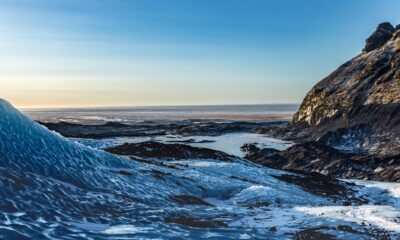Gadgets
This giant polar reptile once stalked an ancient super-ocean

In the present-day oceans, sea turtles, marine iguanas, saltwater crocodiles, and sea snakes are the primary reptilian residents among a plethora of mammals and fish. However, fossil evidence indicates that about 252 million years ago, reptiles dominated the seas. An international team of scientists has recently unearthed the oldest fossil of a sea-dwelling reptile from the Southern Hemisphere. This vertebra fossil belonged to the sea dragon-like nothosaurus and was discovered in a stream bed on New Zealand’s South Island. The findings are detailed in a study published on June 17 in the journal Current Biology.
[Related: New species of extinct marine reptile found with help from 11-year-old child.]
When reptiles ruled the seas
Long before dinosaurs roamed the Earth, reptiles reigned supreme in the Earth’s oceans. The most diverse and enduring group of these extinct marine reptiles are the sauropterygians, with an evolutionary history spanning over 180 million years. Sauropterygians included the long-necked plesiosaurs, resembling the popular image of the Loch Ness Monster.
The nothosaur was a distant predecessor of the plesiosaurs, measuring approximately 23 feet in length. They used four paddle-like limbs to swim and had flattened skulls with slender conical teeth for catching fish and squid.
The nothosaurus vertebra discovered in this study dates back to a time when present-day New Zealand was situated on the southern polar coast of the vast super-ocean known as Panthalassa. Following a mass extinction event called the Great Dying, which devastated marine ecosystems about 250 million years ago, surviving reptiles seized the opportunity to thrive in Earth’s oceans.
Evidence of this pivotal evolutionary moment has been found on the Arctic island of Spitsbergen, northwestern North America, and southwestern China. The single nothosaur vertebra fossil in this study represents one of the latest discoveries from that era, shedding new light on the history of ancient sea reptiles in the Southern Hemisphere.
A new look at an old fossil
The New Zealand nothosaur was initially uncovered during a geological survey in 1978, embedded in a boulder in a stream at the base of Mount Harper on New Zealand’s South Island. The significance of this finding was not fully realized until a team of paleontologists from Australia, East Timor, Norway, New Zealand, and Sweden collaborated to examine and analyze the vertebra and other fossils.
“The nothosaur found in New Zealand is over 40 million years older than the previously known oldest sauropterygian fossils from the Southern Hemisphere,” stated Benjamin Kear, a co-author of the study and a paleontologist at The Museum of Evolution at Uppsala University in Sweden. “We demonstrate that these ancient sea reptiles inhabited a shallow coastal environment teeming with marine life within what was then the southern polar circle.”

The oldest known nothosaur fossils date back approximately 248 million years. These fossils have mainly been discovered along an ancient northern low-latitude belt extending from the remote northeastern to northwestern boundaries of the Panthalassa super-ocean.
Surfing the Panthalassa super-ocean
Paleontologists are still deliberating on the origin, distribution, and timing of when nothosaurs reached these distant regions. Some theories suggest that they migrated along northern polar coastlines, swam through inland seaways, or utilized currents to traverse the Panthalassa super-ocean. The new nothosaur fossil challenges these hypotheses.
“By utilizing a time-calibrated evolutionary model of sauropterygian global distributions, we demonstrate that nothosaurs originated near the equator and subsequently spread both northwards and southwards as complex marine ecosystems re-emerged following the catastrophic mass extinction that marked the onset of the Age of Dinosaurs,” explained Kear.
[Related: This Jurassic-era ‘sea murderer’ was among the first of its kind.]
During the Age of Dinosaurs, the Earth underwent a period of intense global warming, allowing these marine reptiles to flourish at Earth’s South Pole. Kear and his team propose that this indicates the ancient polar regions likely served as the primary route for the earliest global migration of the nothosaurus, akin to the extensive migrations undertaken by modern-day whales.
Further research is necessary to validate this, and it will only be possible through the discovery of more remnants of this ancient sea dragon.
“Undoubtedly, there are more fossil remains of long-extinct sea monsters awaiting discovery in New Zealand and other regions of the Southern Hemisphere,” Kear concluded.
Can you rewrite this sentence?
-

 Destination7 months ago
Destination7 months agoSingapore Airlines CEO set to join board of Air India, BA News, BA
-

 Breaking News8 months ago
Breaking News8 months agoCroatia to reintroduce compulsory military draft as regional tensions soar
-

 Tech News11 months ago
Tech News11 months agoBangladeshi police agents accused of selling citizens’ personal information on Telegram
-

 Breaking News9 months ago
Breaking News9 months agoBangladesh crisis: Refaat Ahmed sworn in as Bangladesh’s new chief justice
-

 Guides & Tips9 months ago
Guides & Tips9 months agoHave Unlimited Korean Food at MANY Unlimited Topokki!
-

 Gaming8 months ago
Gaming8 months agoThe Criterion Collection announces November 2024 releases, Seven Samurai 4K and more
-

 Toys11 months ago
Toys11 months ago15 of the Best Trike & Tricycles Mums Recommend
-

 Productivity10 months ago
Productivity10 months agoHow Your Contact Center Can Become A Customer Engagement Center
























